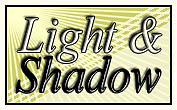Digital Film: Memory cards for Digital Cameras
|
| Camera Sensor | 128 MB Card |
256MB Card
|
512 MB Card
|
1 GB Card
|
2 GB card |
| 3 MP | 74 | 148 | 296 | 592 | 1184 |
| 4 MP | 60 | 120 | 240 | 480 | 960 |
| 5 MP | 50 | 100 | 200 | 400 | 800 |
| 6 MP | 37 | 74 | 148 | 296 | 592 |
| 8 MP | 31 | 72 | 144 | 288 | 576 |
| Camera Sensor | 128 MB Card |
256MB Card
|
512 MB Card
|
1 GB Card
|
2 GB Card |
| 3 MP | 136 | 272 | 544 | 1088 | 2176 |
| 4 MP | 109 | 218 | 436 | 872 | 1744 |
| 5 MP | 88 | 176 | 152 | 704 | 1408 |
| 6 MP | 68 | 136 | 272 | 544 | 1088 |
| 8 MP | 55 | 110 | 220 | 440 | 880 |
Memory Card Formats
One of the more confusing aspects of digital memory card selection is the availability of so many different formats. Once you have decided what size of memory card is required, the card format will then have to be chosen. If you already own a camera, you may not have much choice, as most cameras accept only one type (or at most two types) of memory card. It is best to also consider what brands or types of cameras you are likely to purchase in the future, so you won't be stuck with cards you cannot use, either because of incompatibility, or because a card format has become obsolete; some formats already well on their way too becoming obsolete. There are currently eight major card formats, some of which have sub-classes:
Secure Digital (SD):
A widely used format of small size and available in high capacities. SD is being used more and more in compact digital cameras and other portable electronics due to its small size. Many notebook computers have built in SD card slots to allow easy data transfer without the need for adaptors. At this time, the SD card format looks to be the most likely to become a standard, and is probably the safest bet as far a future support goes. A locking tab is provided to prevent accidental erasure.

Secure Digital card (SD)
Mini Secure Digital (miniSD):
Sixty per cent smaller than an SD card, the MiniSD was designed to go into various ultra-portable devices such as cameras, cell phones and MP3 players. These cards can be used in devices that support regular SD but require an adaptor to do so.
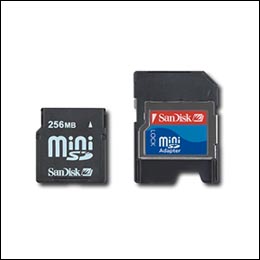
Mini Secure Digital (miniSD)
Compact Flash (CF) Type 1:
Together, SD and compact flash are the two most commonly used memory card formats. CF cards are larger than SD cards, and offer the largest capacities (up to 12 GB at the time of this writing). They are used in many mid to larger sized digital cameras and digital SLR’s. CF is widely supported by many manufactures, but the format may eventually be replaced by SD cards. Some professional digital SLR’s already have support for both CF and SD cards. Type 1 cards are thinner than type 2 cards but have the same interface. Any camera that supports a type 2 CF card will also accept a type 1 card, but not vise versa.

Compact Flash (CF) Type 1
Compact Flash (CF) Type 2:
Less widely used then type 1 cards. Type 2 cards are physically thicker but otherwise similar to type 1. Cameras that support type 2 cards can accept microdives (miniature hard disks which comply with the CF type 2 format. Microdrives are somewhat cheaper than flash memory in terms of cost per megabyte, but the gap is lessening as flash memory prices continue to fall. Two big disadvantages to microdrives are that they consume significantly more battery power, and that they are more susceptible to shock and damage than flash memory.
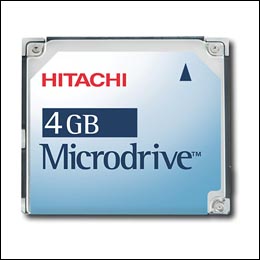
A Microdrive Compact Flash (CF) Type 2
MultiMedia Cards (MMc)
Similar in size and function to SD cards but without the locking tab feature. MultiMedia cards are less widely used Than SD cards and are likely to become obsolete in the near future.
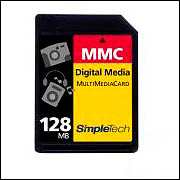
MultiMedia Cards (MMc)
Smart Media:
Small in size but also small in capacity, Smart Media can still be purchased but is already well on its way to becoming a dead format.
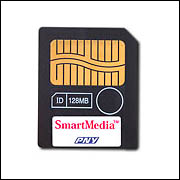
Smart Media card
Memory stick:
This format is used only by Sony products. If you own Sony, you will have to use memory sticks since Sony has chosen not to support the SD or CF formats. This can be quite inconvenient since you cannot share cards between Sony and non-Sony products. Memory sticks are available in high capacities but are larger than SD cards. Newer versions the stick have the PRO designation.
 |
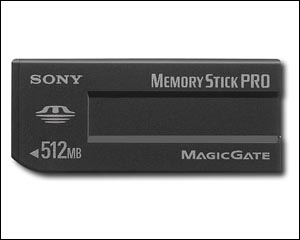 |
Memory stick Duo:
A smaller sized version of the memory stick for more compact applications. As with the full-sized memory stick, the Duo can only be used in Sony products.
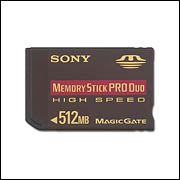
Memory stick Duo
xD Picture Card:
A compact card, available in moderate capacities. The tiny size of this card, (even smaller than SD) makes it hard to grip and easy to lose. This card is used by
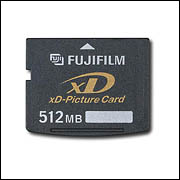
xD Picture Card used by Olympus and Fuji
